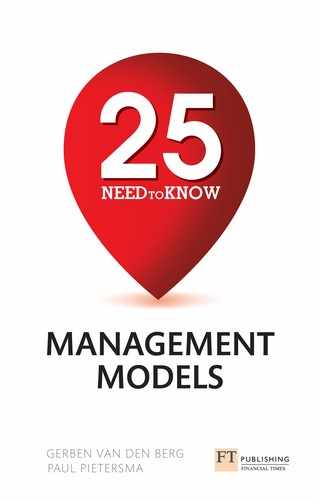Kaizen/Gemba
- Why use it? Kaizen is a tactical tool to help organisations strive for continuous improvement.
- What does it do? Kaizen eliminates waste and inefficiencies; it puts forward good housekeeping and use of standards.
- When to use it? Kaizen can be used to solve several types of problems: process inefficiencies, quality problems, large inventories, and delivery and lead-time problems.
- What question will it help you answer? How can I get my organisation to improve its performance and processes continuously?
The big picture
Kaizen literally means change (kai) to become good (zen). Key elements of kaizen are quality, effort, willingness to change and communication. The Gemba house, as the basis of kaizen, has five fundamental elements:
- teamwork
- personal discipline
- improved morale
- quality circles
- suggestions for improvement.
Based on this foundation, kaizen focuses on the elimination of muda (waste and inefficiencies (Figure 13.1).

Figure 13.1 The Kaizen/Gemba model
Source: based on Imai (1997)
When to use it
Kaizen can be used to solve several types of problems: process inefficiencies, quality problems, large inventories, and delivery and lead-time problems. Employees are encouraged to come up with suggestions during weekly meetings (kaizen events) for small and large improvements. Kaizen suggests eliminating muda (waste and inefficiencies) first. The types of waste are:
- Defective products. Defects in quality prevent customers from accepting the manufactured product. The effort to create these defects is wasted. New waste management processes must be added in an effort to reclaim some value from an otherwise scrap product.
- Over-production. Over-production is the production or acquisition of items before they are actually required. It is the company’s most dangerous waste, because it hides production problems. Over-production has to be stored, managed and protected.
- Transportation. Each time a product is moved, it runs the risk of being damaged, lost, delayed, etc., as well as being a cost with no added value. Transportation does contribute to the transformation of the product that the consumer is disposed to pay for.
- Waiting. Refers to the time spent by the workers waiting for resources to arrive, the queue for their products to empty, as well as the capital sunk into goods and services that have not yet been delivered to the customer. It is often the case that there are processes to manage this waiting.
- Excess inventory. Whether in the form of raw materials, work in progress (WIP) or finished goods, excess inventory represents a capital outlay that has not yet produced an income for either the producer or the consumer. If any of these three items are not being processed actively to add value, it is waste.
- Motion. In contrast to transportation, motion refers to the worker or equipment, and is represented by damage, wear and safety. It also includes the fixed assets and expenses incurred in the production process.
- Extra processing. Using a more expensive or otherwise valuable resource than is required for the task, or adding features that are included in the design but are not needed by the customer. There is a particular problem with this factor. People may need to perform tasks for which they are overqualified to maintain their competency. This training cost can be used to offset the waste associated with over-processing.
After the reduction of waste, good housekeeping is put forward, which comprises the 5-Ss:
- Seiri – tidiness. Separate what is necessary for the work from what is not. This should help to simplify the work.
- Seiton – orderliness. You can increase efficiency by making deliberate decisions regarding the allocation of materials, equipment, files, etc.
- Seiso – cleanliness. Everyone should help to keep things clean, organised, and looking neat and attractive.
- Seiketsu – standardised clean-up. The regularity and institutionalisation of keeping things clean and organised as part of ‘visual management’ is an effective means of continuous improvement.
- Shitsuke – discipline. Personal responsibility for living up to the other 4-Ss can make or break the success of housekeeping.
The last building block of the Gemba house is standardisation. Standardisation of practices and institutionalisation of the 5-Ss will make it easier for everyone in the organisation to improve continuously, including newcomers. Top management plays an important role in guarding and acting for the widespread implementation and coordination of kaizen, the 5-S method, and the standardisation of work.
How to use it
The following steps should be taken in kaizen events:
- Define the problem and the goal of the event.
- Analyse the facts.
- Generate possible solutions.
- Plan the solution.
- Implement the solution.
- Check and secure the solution.
It is important that the solution is checked and secured. In the final phase of a kaizen event, people start to seek opportunities for new kaizen events, which may hamper the process of embedding each improvement into operational practice.
The final analysis
The kaizen philosophy resonates well with the speed of change at operational levels in the organisation. The sustainability of the improvements proposed and implemented by people on the work floor is perhaps the strongest argument in favour of kaizen. Its sheer simplicity makes implementation easy, although some cultures may not be as receptive to the high level of self-discipline that the Japanese are able to maintain.
Kaizen has more potential in incremental change situations than in abrupt turnarounds. A culture focused on short-term success and big ‘hits’ is not the right environment for kaizen. Cooperation and widespread discipline at all levels of the organisation are the absolute keys to its success.
Reference
Imai, M. (1997) Gemba Kaizen: A Commonsense, Low-cost Approach to Management. London: McGraw-Hill.
